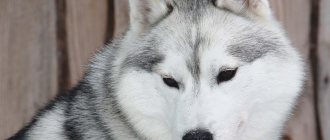Yorkshire Terriers are one of the most popular breeds in Russia and in the world.
Baby Yorkies are popular due to a number of features:
- Mini size;
- Possibility of toilet training in a diaper or in a tray;
- Moderately active character;
- Good interaction with children and other animals;
- Possibility to take with you on trips;
- Easy to care for: visit a groomer every 2-3 months to trim the coat and trim the ears, trim the nails every 2-4 weeks.
- There is no repulsive dog smell.
- Lack of undercoat.
Read the full article about the breed: “The most popular decorative dog is the Yorkshire Terrier (York).”
What influences the development of an animal
Yorkies are small dogs. Their height and weight, as well as their further development, are influenced by genetic factors. Sometimes, to produce small puppies, a standard partner is used for mating, and the partner is smaller than the female.
Various factors can influence the development of dogs
For your information! Mini Yorkie bitches are not used for breeding due to their inability to bear and give birth to offspring normally.
In addition to genetics, there are many other negative factors that affect the development of dogs:
- poor quality food;
- overnutrition of babies;
- poor living conditions;
- lack of essential vitamins and minerals;
- eating disorder;
- use of unacceptable treats in large quantities to reward;
- infection with worms;
- long-term infectious diseases;
- poor health from birth;
- increased calorie intake with low energy expenditure;
- disruption of the endocrine system;
- pathologies of the liver and cardiovascular system.
Note! The development of puppies can also be affected by certain body structure features and imbalances in proportions. The life expectancy of individuals with non-standard sizes is less than that of dogs that meet all standards.
Prenatal period
The period of development inside the womb is divided into several parts. The first stage is completed by the 18th day, development occurs due to food reserves. Next, the liver and kidneys are formed and blood circulation starts.
In the second stage, signs of pregnancy appear in the mother dog. The embryo takes on the shape of a mammal. The nose, eyes, jaws, limbs are formed, the fetus is rapidly increasing. At the end of this period, almost all formation ends, but hair does not appear.
During the last third period, the main growth process takes place: the development of the brain, respiratory tract, bone skeleton, digestion and genital organs.
Stages of growing up by month
The growth of a puppy can be tracked by months. Gradually it will be noticeable how the baby develops and grows. How many months do Yorkies grow and when do they become adults?
Newborns
German Shepherd weight by month: table
Puppies are born blind and deaf. They practically do not move, spend more time sleeping, and eat the rest of the time. Newborn Yorkies are highly dependent on their mother: she feeds them, licks them, and they bask next to her.
Important! It is not recommended to pick up such babies; it stresses out the mother dog. It is better to wait until the puppies begin to move independently, see and hear.
1 month
Newborn Yorkie puppies have their tails docked; when they are 1 month old, the wounds heal. During the first two weeks, the puppies' eyes open and their hearing gradually normalizes. At one month old, babies become very curious, so they need to ensure safety throughout the house.
At the age of 4 weeks, the Yorkshire Terrier gains weight very quickly and becomes almost 3 times larger. The baby is already walking and sometimes tries to run. During this period, you can begin to accustom the dog to new food, gradually moving it away from its mother.
Newborn babies cannot see or hear
2 month
At this time, separation from the mother occurs. The babies become independent and can be given to another owner. Puppies learn quickly, it is important to explain to them many rules of behavior and begin training. Misdeeds are easily punished, successes are rewarded.
Note! At 2 months, babies are already comfortable eating solid food. The new owner must carefully transfer him to a diet that will be followed constantly.
From 3 to 6 months
At this time, the puppy is actively developing: he gets to know the world, communicates with people and other animals. It is important to pay him more attention, train him, and communicate. From the third month, babies' ears begin to rise. This can happen in a variety of ways, so don't worry if your ears remain floppy for a long time.
From the age of 4 months, dogs begin to replace their milk teeth with permanent ones. The process is quite unpleasant, so babies may be nervous, not eat and have trouble sleeping.
From six months to 9 months
The puppy becomes a teenager. At this time, the dog’s character may deteriorate, it begins to be more mischievous and stubborn. However, patience and attention should be exercised so as not to frighten the animal or lose trust. You need to show dissatisfaction, but very carefully.
For your information! Bitches go into their first heat during this period. If further breeding is not planned, then the dog must be sterilized to avoid the further development of serious diseases.
Newborn puppies are very dependent on their mother
9 to 12 months
How old do Yorkies grow? The baby turns into an adult dog closer to one year. It stops growing rapidly, and its mass does not increase either. The dog needs to be switched to adult food and the optimal diet must be selected.
Old age for Yorkies is counted from 8 years, but the animal's life expectancy is approximately 12 years. At this time, it is recommended to change the food and, if necessary, the conditions for keeping the pet.
Similar signs
By the dog's behavior before giving birth, you can determine when it will start giving birth.
- 4 - 5 days before giving birth, the dog experiences a slight sagging of the back caused by prolapse of the uterus.
- Also, the imminent birth can be judged by rapid breathing and a decrease in body temperature.
- Some individuals begin to get nervous 7-10 days before giving birth and refuse to eat, others, on the contrary, eat more, behave as actively as possible, and like to take long walks.
- Before giving birth, the bitch behaves restlessly, looking for a quiet and secluded place where she will be comfortable giving birth and feeding puppies.
The dog should not be allowed to hide - the birth should take place in full view of the owners so that they have the opportunity to help the puppy or bitch.
Puppy weight by month in the table
Chihuahua weight by month and week: table
The Yorkie's weight changes by month are shown in the table below.
| Age | Weight |
| newborns | 160 g |
| 1 month | 595 g |
| 2 month | 940 g |
| 3 months | 1280 g |
| 4 months | 1760 g |
| 5 months | 2040 |
| 6 months | 2240 g |
| One and half year | 2730 g |
This table is only an example.
Don't worry if the weight differs slightly from the standard parameters. In general, the puppy quickly catches up with the required indicators. The dimensions (length and width) of the baby are not recorded, because the puppy may not immediately grow in proportion. The dog should be measured as an adult. For normal development, your dog will need various vitamins and minerals.
After reaching several months, puppies begin to actively explore the world
After
During the week after birth, you need to give your pet 1 tsp 2-3 times a day. milk with calcium. You should not feed your Yorkie meat; it can cause eclampsia, a severe form of toxicosis.
It is better to feed a lactating bitch with high-calorie ready-made industrial food.
You can bathe your dog only 7 days after birth; before that, only wiping with a damp towel is allowed.
Height and weight of an adult Yorkshire Terrier
The required minimum weight and height of Yorkies is not specified in the standards. It is important that the weight does not exceed a certain value, the possible maximum is 3.2 kg.
Kitten weight by month: correct ratio table
An adult girl of this breed weighs on average 2.7 kg, the weight of boys is slightly higher and can reach 3.2 kg. These indicators are important for animals performing at exhibitions and participating in breeding. For pets, the norms are not considered particularly important, provided that the dog does not have diseases and does not develop obesity.
For your information! It is impossible to accurately determine the weight of an adult animal from a puppy. However, there is a method that is sometimes used - the weight of the baby at 8 weeks is multiplied by 3. The resulting figure is the approximate weight of an adult pet.
A little about sizes
The official breed standard adopted by the FCI and RKF does not provide for the division of Yorkshire terriers into varieties by weight or appearance. However, in accordance with the conventional gradation common among dog breeders, Yorkies are divided into:
- Standard – from 2 to 3.2 kg.
- Mini – from 1.4 to 2 kg.
- Super - mini or micro - up to 1.5 kg.
Separately, it is worth noting baby face Yorkies, which are characterized by a shorter muzzle (its length is a third of the length of the skull), a snub nose and large bulging eyes. Varieties of mini, super-mini, micro and baby face Yorkshire terriers are not related to the breed standard and initially did not carry breeding value and were not of interest to breeders, but over time they became fashionable and became widespread.
Gaining weight and height in Mini Yorkies
The breed is not clearly divided into several species, but Mini Yorkies are often distinguished separately. The change in weight in such babies can be seen in the table below:
| Age | Weight |
| newborn | 115 g |
| 1 month | 370 g |
| 2 months | 610 g |
| 3 months | 850 g |
| 4 months | 1110 g |
| 5 months | 1300 g |
| six months | 1450 g |
| one and half year | 1820 |
As adults, Mini Yorkies weigh approximately 2 kg. Babies who do not meet the norm are more likely to be susceptible to various diseases and have a lower life expectancy.
A properly selected diet is the key to a puppy’s good development.
Necessary preparation for childbirth
Giving birth to a Yorkie at home is not scary if you prepare in advance. If you have any difficulties or questions, it is advisable to consult a veterinarian.
The first and most important thing you need to give birth is a place. It should be private and warm. You can use a special oilcloth as bed linen. You should also place a bowl of water and food next to this place.
Important! It's best to stock up on disposable diapers. In the future, they will also be useful for postpartum care.
To process puppies you will need:
- a dropper to remove mucus from the nose;
- sterile scissors for cutting the umbilical cord;
- threads, cotton wool and bright green - for processing.
Also, just in case, you should get the following medications:
- calcium gluconate;
- oxytocin;
- no-shpa;
- diphenhydramine;
- saline;
- alcohol;
- bright green;
- syringes.
Your veterinarian will tell you in detail about their possible uses. Owners who have never given birth are advised to consult a specialist and clarify all questions of interest.
Important! Long hair will only get in the way during childbirth. Therefore, the dog should be cut in the abdomen and groin area. You will also need to trim the animal's nails.
Beard on belly
What to do if the puppy is behind the norm
Often owners are concerned that the puppy does not reach the required weight and size by a certain age. In this case, you should not immediately worry and worry; the standard indicators in most cases are average.
All dogs are individual and develop differently; by the age of one and a half years, they usually reach normal weight and size.
Note! Children often do not eat well when their teeth change.
The owner is advised to carefully review the baby’s diet; perhaps the necessary vitamins and minerals should be added. It is important that the food contains enough fats, proteins and carbohydrates. It is worth selecting it according to the age of the dog and giving preference to a quality product. However, you should also not overfeed your puppy, as this can lead to obesity.
It is necessary to carry out antihelminthic prophylaxis on time, because parasites can also cause a lack of required weight.
If the problem is critical, it is recommended to visit a veterinarian. You may need to undergo tests and find the appropriate treatment. It is important to check your baby in time for the presence of serious infectious diseases that can cause disruption of the digestive system and weight loss.
It is important to provide quality physical activity to Yorkies
Common Yorkie Diseases
Every veterinarian will describe the breed as susceptible to numerous diseases:
- hypoglycemia;
- allergies;
- indigestion;
- renal failure;
- cataracts, glaucoma, infectious lesions of the visual organs;
- dermatitis, baldness;
- hernias;
- bronchitis, weakened respiratory function;
- caries, periodontal disease, difficulty changing teeth;
- open fontanel.
It is difficult to treat Yorkies because they are difficult to tolerate injections of anesthetics.
A breed-specific pathology is distichiasis - the presence of an additional row of eyelashes growing towards the eyeball, injuring the mucous surface. Of the pathologies of the musculoskeletal system, the most commonly diagnosed is Legg-Perthes defect, accompanied by destruction of the integumentary tissues of the femurs, resulting in lameness.
Smart and mischievous, the Yorkshire Terrier is a wonderful pet for apartment living. Suitable for novice dog lovers, childless families or with schoolchildren, and elderly people. This is a wonderful friend, a brave protector, a companion for car trips.
HOW TO CARE FOR YOUR YORKSHIRE TERRIER
For many people, choosing a Yorkshire Terrier as a pet is based on its small size...
TOP 5. THE MOST BEAUTIFUL DOG BREEDS
Perhaps the very first animal with which people shared their home was a dog. Subsequently this...
YORKSHIRE TERRIER – COMPANION DOG
In terms of popularity, the Yorkshire Terrier breed has not been losing ground for many years. They are willingly turned on...
WHEN AND HOW TO VACCINATE YORKSHIRE TERRIER PUPPIES
Why do Yorkie puppies get vaccinated? When and how vaccination is carried out, against what diseases. Preparation…
PREGNANCY AND BIRTH IN THE YORKSHIRE TERRIER
The course of pregnancy and childbirth in a Yorkshire terrier, the owner’s assistance in the birth process, rules of care and...
STERILIZATION OF A YORKIE: IS IT WORTH CARRYING OUT FOR A BOY AND A GIRL
Castration of a Yorkie – is it worth doing, the pros and cons of the procedure. Sterilization of a Yorkie, features, when you can...
HOW TO CUT YOUR YORKSHIRE TERRIER
There are many types of Yorkie haircuts. In this article we will figure out which haircuts are suitable for Yorkies...
BED FOR A YORKSHIRE TERRIER: HOW TO CHOOSE
The Yorkshire Terrier should have a private place where he can retire. It should only belong...
COMBES FOR YORKIES. WHICH ONE TO CHOOSE?
It's time to figure out what combs for Yorkies you need to have. Success in grooming on...
CLOTHING FOR DOGS. HOW TO DRESS A YORKIE
Every owner of a Yorkshire Terrier understands that his little friend is also a member of the family and...
YORKSHIRE TERRIER - DESCRIPTION AND CHARACTER OF THE BREED
More and more people are choosing Yorkshire Terriers as pets. But what did this breed deserve...
The problem of obesity and how to lose weight
If the dog's diet is incorrect, then it is possible that the dog may exceed normal body weight. Yorkies are prone to obesity if they are overfed and not given the necessary exercise.
Excess weight often causes the development of serious diseases (diabetes, etc.), problems with joints and breathing, liver pathologies, and high blood pressure. Excess weight negatively affects appearance and life expectancy.
Getting rid of obesity is possible with strict adherence to the diet and a properly selected diet. All necessary substances must be present in food.
Important! The serving size and calorie content should be appropriate according to the dog's energy expenditure. The diet should be based on the age and size of the pet.
It is important to give Yorkies the necessary physical activity; this will allow the dog to spend more energy and maintain normal physical shape.
Knowing to what age Yorkshire terriers grow, you should choose the necessary diet in time and monitor the physical condition of the dog.
The weight of an adult dog depends on proper maintenance
Possible complications
The birth of a Yorkshire Terrier most often occurs without complications. Problems arise if the bitch has a narrow pelvis and is unable to give birth on her own. In this case, a caesarean section is required. A sign of the need for surgery is a dirty gray discharge that appears shortly before birth. It is also important to ensure that during birth all the placenta comes out - their number should be equal to the number of puppies. Placences that do not come out during childbirth may come out within 24 hours afterward; if this does not happen, the dog must be shown to a veterinarian.
The smallest Yorkie in the world
The smallest Yorkie in the world is considered to be a dog that was born in Great Britain. At birth, the baby's weight was only 70 g. After some time, he grew up, but his weight did not increase much. However, the weight does not prevent this puppy from bringing a smile and tenderness to everyone.
Another small Yorkshire terrier is included in the Guinness Book of Records, whose height reached only 6 cm. The weight of this dog was 113 g, her name is Sylvia. The puppy was born in Blackburn, a city in the north-west of England.
Unfortunately, non-standard dogs are more often susceptible to various diseases:
- hypoglycemia;
- apathy, drowsiness;
- disorders of the digestive system;
- gum disease;
- increased risk of fractures and joint diseases;
- otitis and ear diseases;
- non-overgrowing fontanel;
- intolerance to various types of anesthesia and painkillers.
Mini breed females are not allowed to reproduce because they are not able to bear and normally give birth to healthy puppies. In addition, some varieties suffer from genetic disorders of the physical structure, for example, Baby Face Yorkies are predisposed to diseases of the nose and eyes due to the non-standard structure of the muzzle. Biewers are also susceptible to many diseases.
If necessary, your Yorkie's weight by month can be tracked using various tables. It is important to choose the right diet and care for your baby so that he develops well and quickly. It is worth remembering that Yorkies that do not meet breed standards often get sick and live shorter lives. If all the rules are followed, puppies grow and gain weight quite quickly. If any suspicious signs arise, the dog is not growing and is not gaining weight well, then it is better to contact a veterinarian to prevent the possible development of dangerous diseases.
Vices of non-standard dogs
Representatives of the breed that do not meet the standard have a lot of health problems. So, in Yorkies that are too light, the following are most often observed:
- Hypoglycemia.
- Drowsiness, lethargy, lack of coordination of movements caused by hypoglycemic shock.
- Digestive problems.
- Periodontal disease.
- High probability of fractures.
- Joint diseases.
- Dislocation of the kneecap.
- Tracheal collapse.
- Otitis.
- Cryptorchidism.
- Non-overgrowing fontanel.
- Legg-Calvé-Perthes syndrome.
- Intolerance to anesthesia.
Also, female mini or micro Yorkies are not allowed to breed - they cannot bear and give birth to healthy puppies on their own. To get small puppies, standard females are mated with small males. The structural features of the Baby Face Yorkie's muzzle are the cause of chronic conjunctivitis (due to a narrow tear duct and frequent eye injuries) and breathing problems, which is why the dog can “grunt” while moving and snore.
The life expectancy of non-standard representatives of the breed is much lower: 10 - 12 and 7 - 9 years for mini and super mini Yorkies, respectively.











